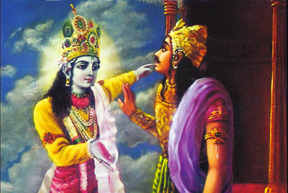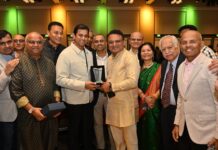 In the previous two articles, we discussed the nature of worldly happiness and unhappiness and learned that there is no happiness or unhappiness in any object or person of this world. Thus, even though Shree Krishna explained to Arjun that by performing his dharm, he would receive more worldly enjoyments (by gaining the kingship through victory in the war, or by getting a good destiny and more prosperity in his next birth), Arjun was not sufficiently motivated to get up and fight.
In the previous two articles, we discussed the nature of worldly happiness and unhappiness and learned that there is no happiness or unhappiness in any object or person of this world. Thus, even though Shree Krishna explained to Arjun that by performing his dharm, he would receive more worldly enjoyments (by gaining the kingship through victory in the war, or by getting a good destiny and more prosperity in his next birth), Arjun was not sufficiently motivated to get up and fight.
He was not interested in obtaining the pleasures of this world (chapter 1, verse 32). Krishna also offered the attainment of Swarg as an incentive. He told Arjun that even if he were killed in the battle, since he had performed his dharm, he would go to Swarg after death (chapter 2, verse 37). Let us see if this motivated Arjun to fight.
What is Swarg and where is it?
First, we must understand what Swarg is. In English it could be translated as heaven or celestial abodes. It is not the same as God’s supreme Divine abode. Swarg is a part of the material manifestation, and is a product of Maya. Thus, when the universe dissolves, Swarg is also dissolved. Swarg is a real place, where souls can go and reside temporarily as a reward for good karm.
Swarg is in its own dimension, yet included within the realm of Maya. However, it cannot be perceived with the senses that we use to perceive this world. Thus, it is not visible to us, even though it is a real place. After death, a soul may be transferred to Swarg, in which case it would receive a celestial body and senses in order to perceive and enjoy the celestial world.
Do you stay in Swarg forever?
No. Those souls who gain access to Swarg only remain there temporarily (chapter 9, verse 21). The length of a soul’s stay in Swarg depends on the amount of punya they have accumulated with their good actions in this life. As pleasures are received in Swarg, the punya is gradually used up, and eventually that soul is removed from Swarg and returned to life on earth.
It is similar to spending your savings when you go away on vacation. The punya are your savings, which you accumulate by following dharm. The more savings you have, the longer you can remain on vacation. However, while on vacation you are only spending, you are not earning more.
Similarly, while in swarg, you use up your punya, but cannot earn more. Eventually you end your vacation and return to work so that you can earn more – eventually you must leave Swarg and return to earth where you can earn more punya.
The human life form which exists on earth is the only life form that can perform karm. All other life forms merely receive the good and bad results of the karm they performed the last time they were human. Their doings are not counted for anything, and will produce no future result, neither reward, nor punishment. Thus, they are called bhog yoni.
But humans are called karm yoni because they have the right to perform karm, and that karm is received as prosperity or suffering in future births. It means that the human life form is where we perform our actions, and other life forms are only the means of undergoing the consequences of those actions. For this reason, no one stays in Swarg forever – they are returned to earth, where they eventually receive another human birth.
Is there real happiness in Swarg?
No. The happiness of Swarg is the same as the happiness of this world, which was previously explained to be an illusion of the mind. In fact, when we go to Swarg, we go with the same mind. Mind and soul are always together in every birth. Thus, even when we go to Swarg, we go with the same desires, attachments, anger, and jealousy that we have in our mind now. The only difference is, that we have earned a higher standard of material pleasure which we can enjoy. So the enjoyments are greater, but the happiness (or lack of) is the same.
Taittariya Upanishad describes 10 levels of Swarg, where the status of enjoyment keeps increasing 100 fold as you go up each level. Which means that in the topmost abode of Swarg – called satya lok or brahm lok – the level of enjoyment would be 100,000,000,000,000,000,000 (100 billion billion) times greater than the greatest enjoyment of this earth. Yet, it would still fail to satisfy the soul’s thirst for Divine happiness. Even that happiness of satya lok is limited in amount and temporary in duration.
The residents of Swarg are also jealous of their neighbors who enjoy greater pleasures due to their greater punya. It is said that even Indra, who is the king of the celestial gods, or devtas, is jealous of Brahma, who has a higher abode and more power than him (surpatir brahmam padam yachate).
Yet even Brahma’s celestial abode is temporary (chapter 8, verse 16) because it is under Maya. So when the mayic universe is dissolved during pralay, Swarg is also dissolved, leaving only God’s Divine abode at that time.
For those who wish to reach God’s Divine abode and stay there forever, they cannot do so from Swarg. They have to receive a human birth on earth and perform the required karm to reach that Divine abode. This is why Shree Krishna later tells Arjun that those who strive to attain Swarg, viewing it as the ultimate attainment, are ignorant (chapter 2, verse 42 & 43).
Thus, Arjun was not sufficiently motivated by the incentive of attaining Swarg. He wanted something more. How to attain the ultimate happiness desired by the soul is described by Shree Krishna in the verses that follow, which will be explained in the next article.
Disciple of Shree Kripaluji Maharaj:
Swami Nikhilanand Ji is a Canadian born Hindu spiritual leader based in Austin, Texas. He is a sanyasi disciple and pracharak of Jagadguru Shree Kripaluji Maharaj.
Attracted to the teachings of Hinduism from a young age, Swamiji eventually let his deep spiritual longing lead him to India, where he was most fortunate to come under the guidance of Shree Kripaluji Maharaj.
Thereafter, living in the ashrams of JKP, he extensively studied Hindi, the philosophy of the prime Sanskrit scriptures (Vedas, Darshan Shastras, Gita, Bhagwatam), and practiced meditation in the tradition of raganuga bhakti. In 2003, he was given sanyas.
Now, with the blessings of his Guruji, he offers satsang programs throughout America, engaging audiences with his clear explanations of Hindu philosophy coupled with inspired chanting of Sanskrit mantras and shlokas and charming nam sankirtan. His informative and compelling speeches provide practical insight into how to adopt the teachings of Sanatan Dharm into our daily lives, and inspire us to awaken our inner spiritual potential.
To stay in touch with Swami Nikhilanand Ji, like his Facebook page at https://www.facebook.com/SwamiNikhilanand or follow him on twitter at https://twitter.com/Swami_Nikhil.
Swami Nikhilanand





